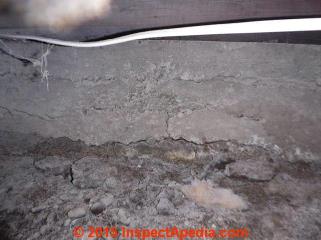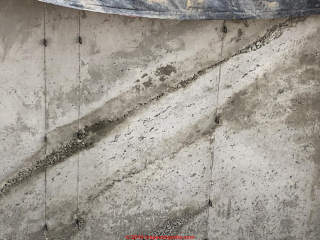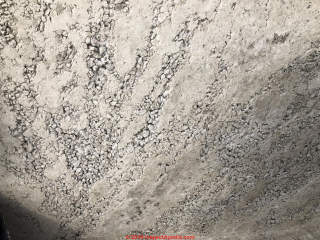 Foundation Damage & Repair Q&A#2
Foundation Damage & Repair Q&A#2
Assess Foundation Cracks, Leans, Bulges, Settlement, FAQs
- POST a QUESTION or COMMENT on how to evaluate, diagnose, & repair foundation cracks, leans, bulges, movement, damage
Q&A#2 on how to assess foundation damage.
This article series describes in detail how to recognize, diagnose & repair various types of foundation failure or damage, such as foundation cracks, masonry foundation crack patterns, and moving, leaning, bulging, or bowing building foundation walls.
InspectAPedia tolerates no conflicts of interest. We have no relationship with advertisers, products, or services discussed at this website.
- Daniel Friedman, Publisher/Editor/Author - See WHO ARE WE?
Q&A on Evaluating Foundation Cracks, Movement, & Condition
 These questions & answers about assessing types of foundation damage and movement and its repair were posted originally
These questions & answers about assessing types of foundation damage and movement and its repair were posted originally
at FOUNDATION CRACKS & DAMAGE GUIDE - home; that's a good place to start reading about how to assess damage and what to do about it.
On 2019-03-02 by (mod) - cold pour joints & poorly-mixed concrete placement
Your photo shows a cold pour joint in the concrete. Usually these are not a structural problem though sometimes they become a foundation leak point.
See details at CONCRETE COLD POUR JOINTS
Separately: if the foundation is not set on and tied to the footing that might or might not be serious depending on the footing and foundation specifications - you need help from an architect or engineer who can examine the foundation plans and compare those with the as-built situation.
On 2019-03-02 by Jeff
Thanks for the quick response!
These were poured by a cement truck/pump I believe. Yes these are steel reinforced foundation walls.
A few other things we noticed yesterday on closer inspection.
1. There’s a long diagonal line which looks like a cold joint (photo attached).
2. One of the foundation wall “T-Walls” is not centered on the footing-It looks like it’s hanging off the edge.
3. The exterior walls are a max of 8 inches, but some are under that (Plans called for 8 which I believe is consistent with code)... Is there an acceptable margin?
Thanks again for the help!
On 2019-03-01 by (mod) - poorly-mixed concrete
 I'm not sure about applying the word "normal" but "common" fits - in that incompletely-mixed concrete pours can look like that in your photo.
I'm not sure about applying the word "normal" but "common" fits - in that incompletely-mixed concrete pours can look like that in your photo.
Was this delivered by a concrete truck or mixed by hand?
Is this a steel reinforced concrete foundation wall?
On 2019-03-01 by Jeff - honeycomb appearance of new concrete foundation walls
Hello,
We are building new construction in Wisconsin and the foundation walls were poured this week (I should note it was very cold (15 degrees F) on the day of the pour).
We noticed quite a bit of “honeycomb” on the foundation walls. Curious how normal this is or if I should be concerned. Happy to provide any additional information or more pictures. Thank you for the help!
On 2018-03-07 by (mod) -
I'd be glad to take a look at photos of the situation; use the ADD IMAGE button to the right of the Comment button if you want to attach an image to a comment.
On 2018-03-07 by Michelle
Thanks for that opinion! It jives with my sense of the situation from some small scale past work with foam and caulk in different applications. Thanks you :)
On 2018-03-07 by (mod) - foam sealant vs other crack sealers like caulk
Michelle
My OPINION - which means there is no absolute answer when we have no specific details about the situation - is that the foam sealant, as it expands, will move more deeply into a foundation crack and form a better seal - all else being equal.
Dirt in the crack will foul any sealing attempt as will ongoing foundation movement.
On 2018-03-06 by Michelle
Hi there,
We're ready to address four foundation cracks (primarily vertical, none more than 1/4") and I'm confused by our DIY options.
I'm seeing polyurethane FOAM kits that cost around $100, but the TrueValue site says to use "Polyurethane, silicone, or latex concrete caulk" which seems to be significantly cheaper.
I imagine that the poly foam is better at reaching the depths of a crack, where caulk sits more on the surface (even if you use a brush or some other tool to force it into the crack). Is that correct? Which is preferable for long-term moisture prevention in a Midwest basement? Is the much more expensive foam really worth its price?
Thanks for any advice!
On 2017-09-01 by (mod) - big bulge in garage floor
Tammy,
Probably, yes, you can tear out a garage floor and remove roots causing floor damage - certainly less expensively than rebuilding the whole structure, but with some warnings that merit thought:
1. you may encounter steel re-bar or wire mesh reinforcement in the concrete that will make removal a bit more work than you expect
2. you will need to replace and properly connect new reinforcement to the old existing wire mesh or rebar when re-pouring the floor
3. the tree that sent in roots will send them again if it can, or killing the roots may also kill the tree that then falls on the garage
4. you want to review handling the roof runoff from the garage roof to be sure water isn't going under the garage floor slab or you'll be inviting future root or perhaps frost damage
On 2017-09-01 by tammy
I am in the process of purchasing a home that was built in 1940's. The garage, which is totally detached from the house and 15 feet away from the main house has a significant bulge/crack in the concrete slab floor because of tree roots. Is it possible to just break out the floor, remove the tree roots and repour a new floor?
On 2017-04-21 by (mod) - IF the damage is confined to the slab
B
IF the damage is confined to the slab, that is if the foundation walls are not cracked, settling, moving, the the damage is at least not threatening the structure; still you will want to do what you can to get water away from the building and to seal the crack.
You can consult with an experienced foundation contractor; if she sees serious concerns you might need help from a licensed foundation engineer too.
Most of the time when I see a water problem it's not from a high water table it's from roof spillage by the foundation or site drainage towards the building.
On 2017-04-21 by B
We have a family lake cottage built in the 50's on a slab located on a very high water table with slightly less than 1/4" crack across entire main living room area.
We don't see water coming through it, but do have 2 pumps on each side of house that when electricity goes out, water comes in other areas.
We are looking at options for improving drainage on exterior and a backup situation for outages, but our question is who to go to in order to determine if the foundation needs repair. We are in lower mid-michigan.
On 2016-10-11 by Betty
I have a block foundation on a about a 40 year old house. One corner I have step cracking along morter joints and on same corner other side I have a hairline crack going ground to window not in morter joints. Structural engineer said he did'nt think it was anything to worry about.
Crew began to build new deck which they put new 6" post against the corner but in the process pulled off old bolted joist that was adhered to the concrete wall. Apparently there were large holes in the concrete block where each toggle was.....and they put a joist board over it.
.but about a 3x3 rectangular hole is showing at behind the edge of the new board. Crew says it's nothing to worry about because the holes were there before...I contend that the holes are now open to rain, ice, and cracking that will slowly but surely make my house corner fall apart. They do not want to tear down what they have constructed..what should I do?
On 2016-07-25 by (mod) - steps in foundation damage assessment and repair
Sanal you are welcome to use the page top or bottom CONTACT link to send us photos of foundation cracks as well as more distant photos of the site and sides of teh whole building for context. Keep in mind that no photo nor remote consult can come close to having an onsite foundation expert.
Basically you want to ask:
What do the cracks tell me about building movement - direction, and thus possible impact on structure.
How much movement has there been, over what time period - how fast are things happening
How much movement has disturbed what building components - how much damage is there and what are the risks to the structhre
thus
How urgent are building repairs and what repairs (if any) are needed to the building itself
then
What is the cause of the cracking or movement
thus
what can I expect to happen in the future
and
what foundation repairs are needed (if any).
Depending on what you are seeing, the ARTICLE INDEX to BUILDING STRUCTURES given just above lists types of foundation damage, damage assessment, and repair approaches.
On 2016-07-24 by Sanal
Dear Inspectapedia,
I own a townhouse and recently noticed 2 cracks outside. The house is about 11 years old and we did not have any structural problems previously. Could you take a look and let me know your expert opinion and suggest what my next step should be (I emailed images separately).
Thanks for your help with my query.
Best Regards, Sanal
On 2016-05-11 by (mod) - don't be rushed or you will be sorry - take time to inspect before you buy. Don't throw your wallet ahead of yourself.
Jing,
Watch out: The most-upset home buyers I ever find are those who are forced by circumstance to run towards a property screaming I WANT IT and throwing their wallet and checkbook ahead of themselves.
That's because in the rush to close people do hasty work, make mistakes, or fail to understand the building they are buying. Sometimes they're upset later by what are described as "big surprises".
While nobody should make up hazards to the detriment of a property seller, the buyer should exercise all due diligence - that's standard advice in real estate transactions.
You should not and cannot rely on brief e-text to a stranger or a website to make multi-thousand purchase decision on a home. You need an on-site expert whom you can trust completely, who has true expertise and experience where needed, and who has no conflicts of interest regarding the transaction, seller, realtor, or buyer.
I certainly cannot tell from your posted photos what is the overall condition of the home, its foundation, nor the rest of its structure. Enormously more information is available to a competent home inspector or other on-site building professional.
On 2016-05-11 by Jing - we have until tomorrow to decide if foundation damage is significant
Thanks again for your quick response. That's very helpful. We need to decide tomorrow, so we don't have time to have a profession come to the site. You mentioned that leaning, bowing or bulging will be a big concern along with the cracks.
My foundation consultant gave us a chart showing the leveling of the house, please see the picture I provided. Is it able to tell from this chart that, the house doesn't have settlement movement, and these cracks are not structural problems? Thank you very much!
On 2015-12-06 by (mod) - health risks of prior flooding
There are two reasonable strategies that come to mind for this situation:
1. If there are building-related health complaints or IAQ complaints then it may be justified to hire a professional investigator to determine what was wet or affected by the flooding event and what hazards may remain such as hidden mold reservoirs. See https://inspectapedia.com/sickhouse/IAQ_Investigation.php for help in that decision
2. If you can determine where flooding occurred and what got wet, investigate further in the most-suspect (most-wet area) such as on the back side of floor-wall trim or in the wall cavity behind trim.
On 2015-12-06 by Kesa
I moved into a new rental home a few months ago.
It has come to my attention that this house has been flooded and remodeled within the year.
It was not mentioned in the lease and I want to be safeguard our health.mcanni obtain an inspection report? I cannot find a permit in the county database in this remodel either.
...
Continue reading at FOUNDATION DAMAGE REPORTS or select a topic from the closely-related articles below, or see the complete ARTICLE INDEX.
To understand the cause, effect, and remedy for all types of building foundation or masonry wall damage or movement we have categorized foundation damage into these broad categories:
- FOUNDATION DAMAGE & REPAIR GUIDE: home page for foundation damage assessment & repair procedures.
- FOUNDATION CRACK DICTIONARY, what is the severity of foundation damage, what is its effect on the stability of the structure, and how urgently are foundation repairs needed?
- FOUNDATION FAILURES by MOVEMENT TYPE: is the movement active or not, how is the foundation moving: bulging, leaning, settling, etc. ?
- FOUNDATION FAILURES by TYPE & MATERIAL: how does damage show up in different types of foundation material & what are the implications for collapse risk or repair need?
- FOUNDATION REPAIR METHODS discusses alternative ways to fix a damaged foundation or floor slab crack or movement
Suggested citation for this web page
FOUNDATION CRACKS & DAMAGE GUIDE FAQs-2 at InspectApedia.com - online encyclopedia of building & environmental inspection, testing, diagnosis, repair, & problem prevention advice.
Or see this
INDEX to RELATED ARTICLES: ARTICLE INDEX to BUILDING STRUCTURES
Or use the SEARCH BOX found below to Ask a Question or Search InspectApedia
Ask a Question or Search InspectApedia
Try the search box just below, or if you prefer, post a question or comment in the Comments box below and we will respond promptly.
Search the InspectApedia website
Note: appearance of your Comment below may be delayed: if your comment contains an image, photograph, web link, or text that looks to the software as if it might be a web link, your posting will appear after it has been approved by a moderator. Apologies for the delay.
Only one image can be added per comment but you can post as many comments, and therefore images, as you like.
You will not receive a notification when a response to your question has been posted.
Please bookmark this page to make it easy for you to check back for our response.
IF above you see "Comment Form is loading comments..." then COMMENT BOX - countable.ca / bawkbox.com IS NOT WORKING.
In any case you are welcome to send an email directly to us at InspectApedia.com at editor@inspectApedia.com
We'll reply to you directly. Please help us help you by noting, in your email, the URL of the InspectApedia page where you wanted to comment.
Citations & References
In addition to any citations in the article above, a full list is available on request.
- [1] New York State Department of Engineering, correspondence. D. Hasbrouck, P.E. to DJF.
- In addition to citations & references found in this article, see the research citations given at the end of the related articles found at our suggested
CONTINUE READING or RECOMMENDED ARTICLES.
- Carson, Dunlop & Associates Ltd., 120 Carlton Street Suite 407, Toronto ON M5A 4K2. Tel: (416) 964-9415 1-800-268-7070 Email: info@carsondunlop.com. Alan Carson is a past president of ASHI, the American Society of Home Inspectors.
Thanks to Alan Carson and Bob Dunlop, for permission for InspectAPedia to use text excerpts from The HOME REFERENCE BOOK - the Encyclopedia of Homes and to use illustrations from The ILLUSTRATED HOME .
Carson Dunlop Associates provides extensive home inspection education and report writing material. In gratitude we provide links to tsome Carson Dunlop Associates products and services.

